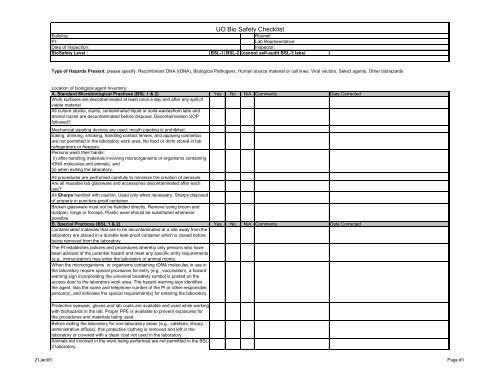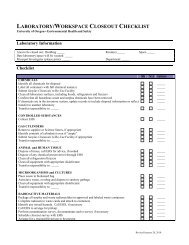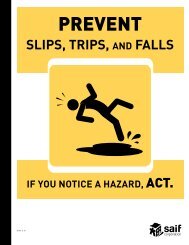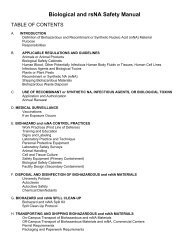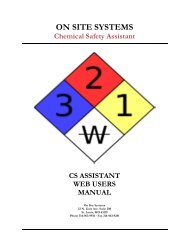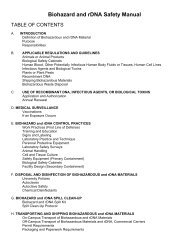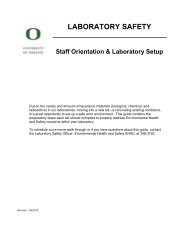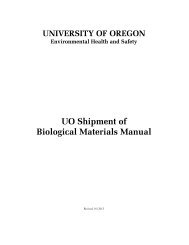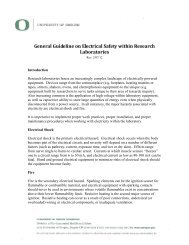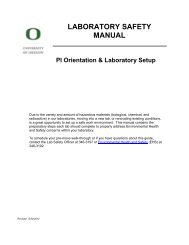Biosafety Checklist Lab Audit - Environmental Health & Safety
Biosafety Checklist Lab Audit - Environmental Health & Safety
Biosafety Checklist Lab Audit - Environmental Health & Safety
Create successful ePaper yourself
Turn your PDF publications into a flip-book with our unique Google optimized e-Paper software.
Building:<br />
PI:<br />
Date of Inspection:<br />
Bio<strong>Safety</strong> Level :<br />
UO Bio <strong>Safety</strong> <strong>Checklist</strong><br />
Room#:<br />
<strong>Lab</strong> Representative:<br />
Inspector:<br />
BSL-1 BSL-2 (cannot self-audit BSL-3 labs)<br />
Type of Hazards Present, please specify: Recombinant DNA (rDNA), Biological Pathogens, Human source material or cell lines, Viral vectors, Select agents, Other biohazards<br />
Location of biological agent Inventory:<br />
A. Standard Microbiological Practices (BSL 1 & 2) Yes No N/A Comments Date Corrected<br />
Work surfaces are decontaminated at least once a day and after any spill of<br />
viable material.<br />
All culture stocks, slants, contaminated liquid or solid wastesfrom labs and<br />
animal rooms are decontaminated before disposal. Decontamination SOP<br />
followed?<br />
Mechanical pipeting devices are used; mouth pipeting is prohibited.<br />
Eating, drinking, smoking, handling contact lenses, and applying cosmetics<br />
are not permitted in the laboratory work area. No food or drink stored in lab<br />
refrigerators or freezers.<br />
Persons wash their hands:<br />
(i) after handling materials involving microorganisms or organisms containing<br />
rDNA molecules and animals, and<br />
(ii) when exiting the laboratory.<br />
All procedures are performed carefully to minimize the creation of aerosols.<br />
Are all reusable lab glassware and accessories decontaminated after each<br />
use?<br />
All Sharps handled with caution. Used only when necessary. Sharps disposed<br />
of properly in puncture-proof container.<br />
Broken glassware must not be handled directly. Remove using broom and<br />
dustpan, tongs or forceps. Plastic ware should be substituted whenever<br />
possible.<br />
B. Special Practices (BSL 1 & 2) Yes No N/A Comments Date Corrected<br />
Contaminated materials that are to be decontaminated at a site away from the<br />
laboratory are placed in a durable leak-proof container which is closed before<br />
being removed from the laboratory.<br />
The PI establishes policies and procedures whereby only persons who have<br />
been advised of the potential hazard and meet any specific entry requirements<br />
(e.g., immunization) may enter the laboratory or animal rooms.<br />
When the microorganisms or organisms containing rDNA molecules in use in<br />
the laboratory require special provisions for entry (e.g., vaccination), a hazard<br />
warning sign incorporating the universal biosafety symbol is posted on the<br />
access door to the laboratory work area. The hazard warning sign identifies<br />
the agent, lists the name and telephone number of the PI or other responsible<br />
person(s), and indicates the special requirement(s) for entering the laboratory.<br />
Protective eyewear, gloves and lab coats are available and used while working<br />
with biohazards in the lab. Proper PPE is available to prevent exposures for<br />
the procedures and materials being used.<br />
Before exiting the laboratory for non-laboratory areas (e.g., cafeteria, library,<br />
administrative offices), this protective clothing is removed and left in the<br />
laboratory or covered with a clean coat not used in the laboratory.<br />
Animals not involved in the work being performed are not permitted in the BSL-<br />
2 laboratory.<br />
21Jan05 Page #1
Special care is taken to avoid skin contamination with organisms containing<br />
rDNA molecules; gloves should be worn when handling experimental animals<br />
and when skin contact with the agent is unavoidable.<br />
An approved disinfectant known to be effective against the organisms in use is<br />
present in the laboratory.<br />
Needles should not be bent, sheared, broken, re-capped or removed from the<br />
syringe following use. Extreme caution should be used when handling needles<br />
and syringes to avoid autoinoculation and the generation of aerosols during<br />
use and disposal.<br />
The needle and syringe should be promptly placed in a puncture-resistant<br />
container labeled Biohazard sharps.<br />
Spills and accidents which result in overt / or suspected exposures to material<br />
containing biological agents are immediately reported to the Institutional<br />
<strong>Biosafety</strong> Officer and the Committee; if rDNA molecules are involved,<br />
notification is first made to the Institutional <strong>Biosafety</strong> Officer, the IBC, and<br />
then to NIH/OBA.**<br />
A biosafety manual is prepared or adopted. Personnel are advised of special<br />
hazards through written SOPs and are required to read and follow instructions<br />
on practices and procedures.<br />
C. Containment Equipment (BSL2) Yes No N/A Comments Date Corrected<br />
Biological safety cabinets (Class I or II) or other appropriate personal<br />
protective or physical containment devices are used whenever procedures<br />
with a high potential for creating aerosols are conducted (see Appendix G-III-L<br />
and Appendix G-III-O, Footnotes and References of Appendix G-NIH<br />
Guidelines ). These may include centrifuging, grinding, blending, vigorous<br />
shaking or mixing, sonic disruption, opening containers of materials whose<br />
internal pressures may be different from ambient pressures, intranasal<br />
inoculation of animals, and harvesting infected tissues from animals or eggs.<br />
Biological safety cabinets (Class I or II) or other appropriate personal<br />
protective or physical containment devices are used whenever high<br />
concentrations or large volumes (10L) of microorganisms or organisms<br />
containing rDNA molecules are used. (see Footnotes and References of<br />
Appendix G).<br />
Are Biological <strong>Safety</strong> Cabinets in use certified annually.<br />
Last Date Certified: Certifier:<br />
No bunsen burners inside biosafety cabinets<br />
All Specimens / Cultures are secured from general access by non-laboratory<br />
associated individuals in freezers and / or incubators? (Lock and key access?)<br />
Are signs with Biohazard symbols posted on all stock culture containers?<br />
Are all biomedical wastes, including gloves and disposable Personal<br />
Protection Equipment items, disposed of only in biohazard-labeled bags?<br />
BBP Exposure Control Yes No N/A Comments Date Corrected<br />
BBP Exposure Control plan on file<br />
Hepatitis B vaccination offered, as applicable.<br />
Post-exposure follow up plan in place and employees informed (red envelope).<br />
Inventory Control Yes No N/A Comments Date Corrected<br />
Work with approved agents and protocols; CDC/USDA Select Agents<br />
registered, handled according to regulations<br />
Waste is disposed of, packaged, and labeled correctly<br />
Training Yes No N/A Comments Date Corrected<br />
Have personnel been trained in the hazards associated with and instructed in<br />
safe-handling methods for the biological agent(s) used in the lab<br />
21Jan05 Page #2
For laboratories working with organisms containing rDNA molecules, have all<br />
personnel read and become familiar with the requirements of the NIH<br />
Guidelines , specifically the Section III reporting requirements for rDNA<br />
activities?<br />
Training for work with agents used<br />
Training for bloodborne pathogens (BBP) exposure<br />
Annual retraining in BBP completed<br />
Engineering Controls Yes No N/A Comments Date Corrected<br />
Hand washing facilities provided and used<br />
Eye wash station available<br />
Autoclave available, used and checked for effectiveness<br />
The laboratory is designed so that it can be easily cleaned.<br />
Bench tops are impervious to water and resistant to acids, alkalis, organic<br />
solvents, and moderate heat.<br />
<strong>Lab</strong>oratory furniture is sturdy and spaces between benches, cabinets, and<br />
equipment are accessible for cleaning.<br />
Flooring and ceiling in good repair<br />
Illumination adequate for all activities<br />
Administrative Controls and Documentation Yes No N/A Comments Date Corrected<br />
<strong>Lab</strong>oratory facility meets criteria for biosafety level<br />
<strong>Lab</strong> properly posted and labeled<br />
Records current and accurate<br />
Access to the on-line <strong>Biosafety</strong> Manual provided and encouraged<br />
Access to the laboratory is limited or restricted as appropriate<br />
Integrated pest management program in place; screened windows<br />
**Reports to NIH/OBA shall be sent to the Office of Biotechnology Activities, National Institutes of <strong>Health</strong>, 6705 Rockledge Drive, Suite 750, MSC 7985, Bethesda, MD 20892-7985 (20817 for non-<br />
USPS mail), 301-496-9838, 301-496-9839 (fax). All Medical evaluations, surveillance, and treatments are provided as appropriate and written records are maintained as required by OSHA and other<br />
agencies.<br />
If you are unsure about any question and for guidance materials, go to:<br />
www.oehs.uoregon.edu<br />
The CDC's <strong>Biosafety</strong> in Microbiological and Biomedical <strong>Lab</strong>oratory book at:<br />
http://www.cdc.gov/od/ohs/biosfty/bmbl5/bmbl5toc.htm<br />
The NIH Guidelines are at:<br />
http://www4.od.nih.gov/oba/rac/guidelines/guidelines.html<br />
21Jan05 Page #3


